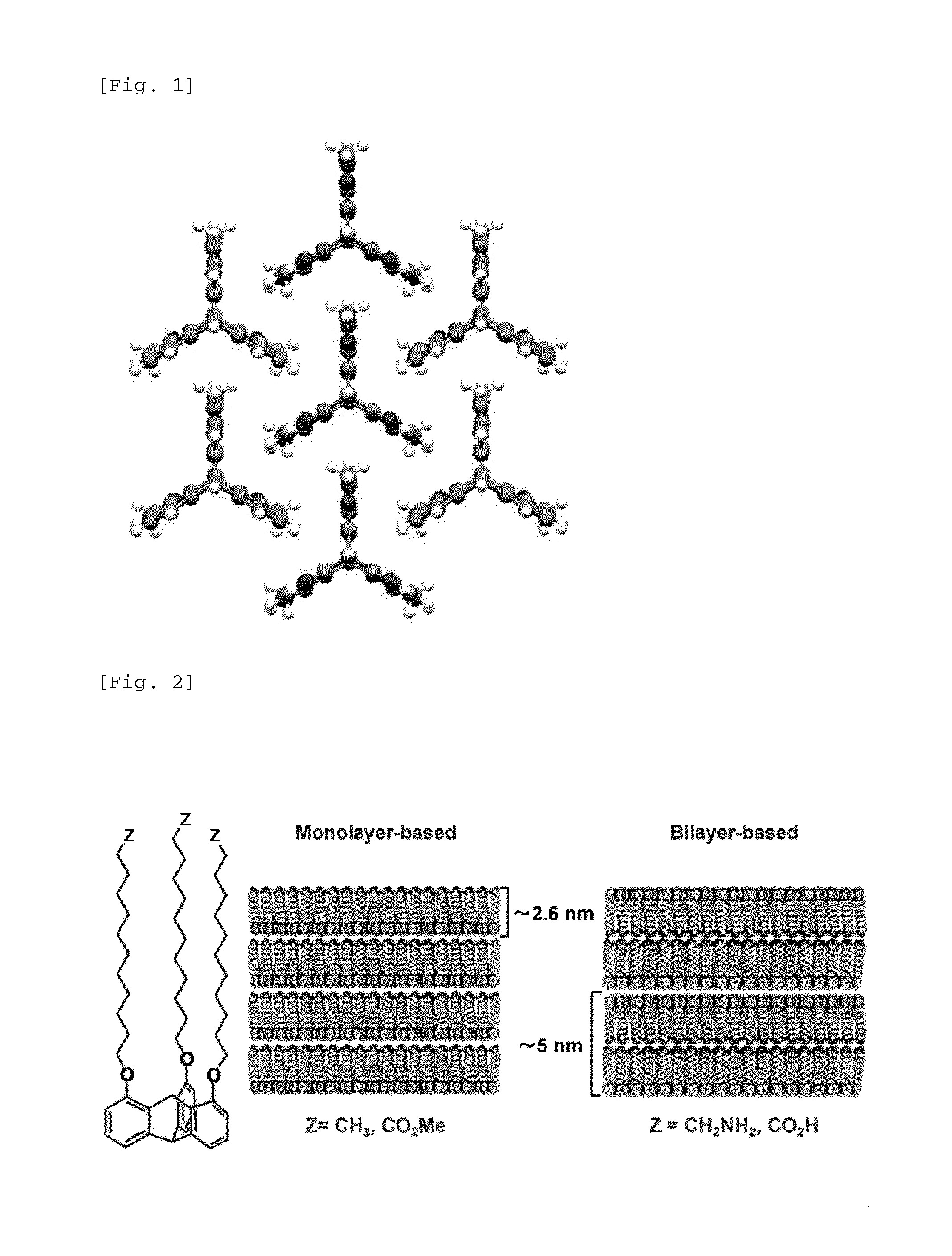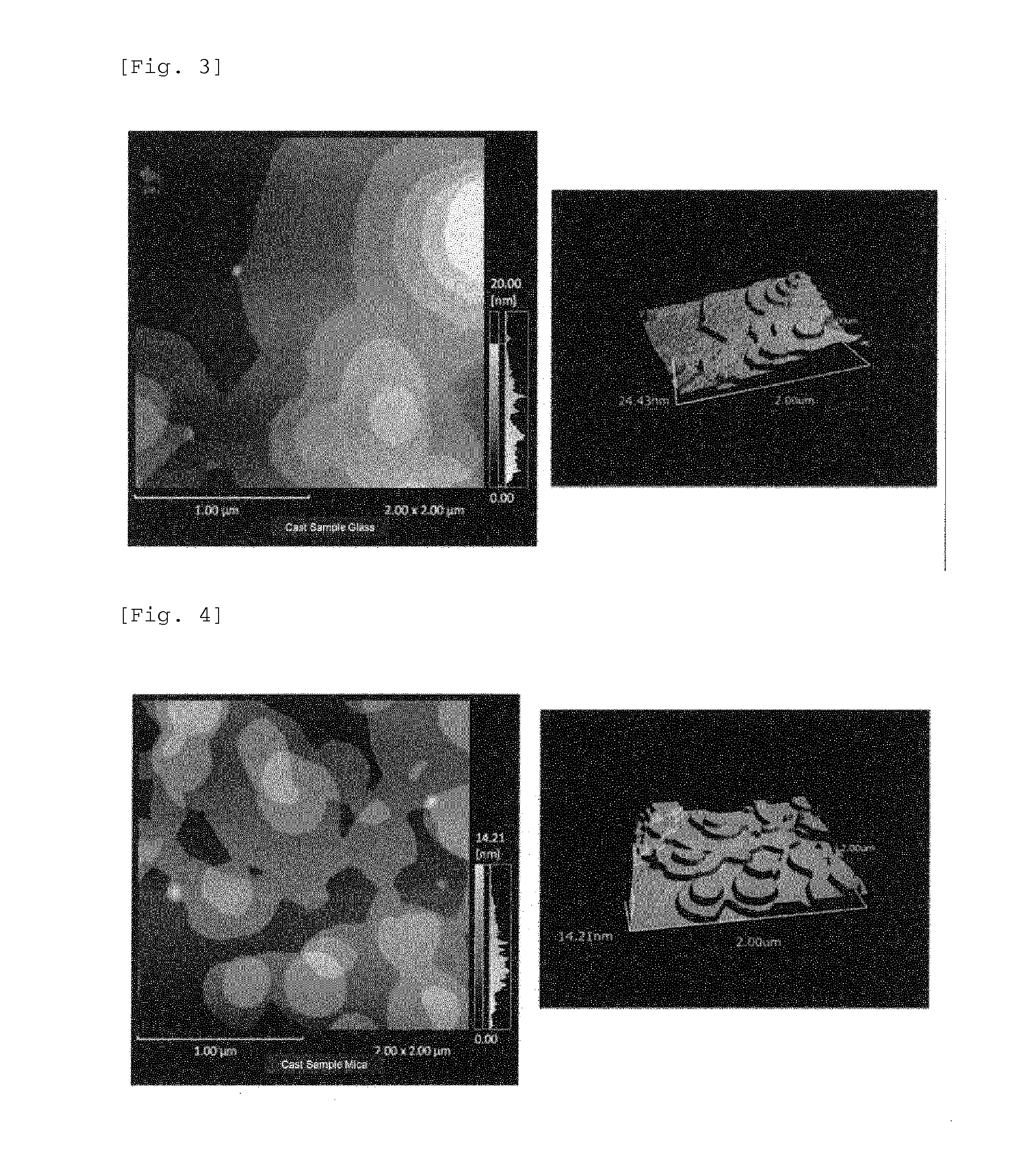Electronic device using organic thin film, and electronic apparatus containing the same
- Summary
- Abstract
- Description
- Claims
- Application Information
AI Technical Summary
Benefits of technology
Problems solved by technology
Method used
Image
Examples
production example 1
Production of Trimethoxytriptycene Mixture Presented Below
[0217]
[0218]A suspension was prepared by adding acetonitrile (750 mL) to 1,8-dimethoxyanthracene (22.3 g, 93.7 mmol) and cesium fluoride (CsF) (85.3 mg, 561.0 mmol) and heated to 80° C. To this suspension, 2-methoxy-6-trimethylsilyloxy-trifluoromethylsulfonate (61.5 g, 188 mmol) was added dropwise, and the mixture was refluxed while heating for 5 hours. Acetonitrile was distilled off from the reaction mixture thus obtained under reduced pressure, the residue was washed with water and then a mixed solvent of hexane / chloroform (1 / 1, v / v), thereby obtaining intended trimethoxytriptycene (yield: 22.2 g, 64.5%). The trimethoxytriptycene thus obtained was revealed to be a mixture of 1,8,13-trimethoxytriptycene (Compound 5a) and 1,8,16-trimethoxytriptycene (Compound 5b) of 2:1 by the NMR measurement.
[0219]Compound 5a:
[0220]1H-NMR (400 MHz, CDCl3): δ(ppm)
7.01 (d, J=0.7 Hz, 3H), 6.90 (dd, J=7.3, 1.0 Hz, 3H), 6.80 (s, 1H), 6.58 (dd, J=...
production example 2
Production of 1,8,13-Trimethoxytriptycene (Compound 5a) Single Crystal
[0223]
[0224]The trimethoxytriptycene mixture (10.0 mg) produced in Production Example 1 was crystallized by dissolving in chloroform and allowing to stand, thereby obtaining 1,8,13-trimethoxytriptycene (2.0 mg) of the title.
[0225]The crystal thus obtained was subjected to the single-crystal X-ray structural analysis, and the result was as follows. This crystal had an orthorhombic crystal system, and the values of a, b, and c of unit cell were 15.608, 13.388, and 8.041, respectively in a unit of angstrom. The value of V was 1680 cubic angstrom.
production example 3
Production of 1,8,13-Trihydroxytriptycene (Compound 6)
[0226]
[0227]To the trimethoxytriptycene mixture (22.0 g, 62.9 mmol) produced in Production Example 1, 320 mL of dichloromethane was added to prepare a suspension, and boron tribromide (BBr3) (18.2 mL, 192 mmol) was added to this, and the mixture was stirred for 4 hours at 0° C. To the reaction mixture, 200 mL of water was added, and the powder thus precipitated was collected by filtration and dried under reduced pressure. The powder thus obtained was dissolved in 80 mL of dimethylformamide, the mixture was allowed to stand at 5° C., and as a result, a colorless crystal was precipitated. This crystal was collected by filtration and washed with chloroform, thereby selectively obtaining 1,8,13-trihydroxytriptycene (Compound 6) (yield: 9.14 g, 71%) of the title.
[0228]Compound 6:
[0229]1H-NMR (400 MHz, acetone-d6): δ (ppm)
8.35 (br, s, 3H), 6.94-6.93 (d, J=7.2 Hz, 3H), 6.86 (s, 1H), 6.79-6.75 (dd, J=7.2, 0.9 Hz, 3H), 6.56-6.54 (dd, J=8....
PUM
| Property | Measurement | Unit |
|---|---|---|
| Dielectric polarization enthalpy | aaaaa | aaaaa |
| Structure | aaaaa | aaaaa |
| Molecular structure | aaaaa | aaaaa |
Abstract
Description
Claims
Application Information
 Login to View More
Login to View More - R&D
- Intellectual Property
- Life Sciences
- Materials
- Tech Scout
- Unparalleled Data Quality
- Higher Quality Content
- 60% Fewer Hallucinations
Browse by: Latest US Patents, China's latest patents, Technical Efficacy Thesaurus, Application Domain, Technology Topic, Popular Technical Reports.
© 2025 PatSnap. All rights reserved.Legal|Privacy policy|Modern Slavery Act Transparency Statement|Sitemap|About US| Contact US: help@patsnap.com



